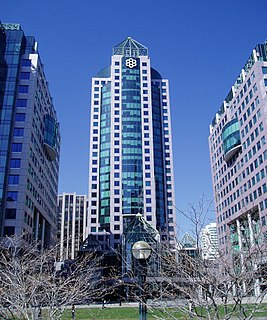Municipal elections were held in Toronto , Ontario, Canada, on December 7, 1953. Incumbent mayor Allan Lamport won an unexpectedly close race against school board trustee Arthur Young. This election was the first for councils in the municipality of Metropolitan Toronto which would be created on January 1, 1954 and was composed of 14 municipalities: the City of Toronto, the towns of New Toronto, Mimico, Weston and Leaside; the villages of Long Branch, Swansea and Forest Hill, and the townships of Etobicoke, York, North York, East York, and Scarborough.

Toronto is the provincial capital of Ontario and the most populous city in Canada, with a population of 2,731,571 in 2016. Current to 2016, the Toronto census metropolitan area (CMA), of which the majority is within the Greater Toronto Area (GTA), held a population of 5,928,040, making it Canada's most populous CMA. Toronto is the anchor of an urban agglomeration, known as the Golden Horseshoe in Southern Ontario, located on the northwestern shore of Lake Ontario. A global city, Toronto is a centre of business, finance, arts, and culture, and is recognized as one of the most multicultural and cosmopolitan cities in the world.

The Municipality of Metropolitan Toronto was an upper tier level of municipal government in Ontario, Canada from 1954 to 1998. It was made up of the old city of Toronto and numerous townships, towns and villages that surrounded Toronto, which were starting to urbanise rapidly after World War II. It was commonly referred to as "Metro Toronto" or "Metro".

Old Toronto is the retronym of the area contained within the original boundaries of Toronto, Ontario, Canada, from 1834 to 1998. It was first incorporated as a city in 1834, after being known as the town of York, and became part of York County. In 1954, it became the administrative headquarters for the Municipality of Metropolitan Toronto. The city expanded in size by annexation of surrounding municipalities, reaching its final boundaries in 1967. Finally, in 1998, it was amalgamated with the other cities of Metropolitan Toronto ; and the borough of East York, into the present-day city of Toronto. This was not a traditional annexation of the surrounding municipalities, but rather a new municipal entity that is the successor of the original city.
Contents
- Toronto mayor
- Board of Control
- City council
- Changes
- Suburbs
- East York
- Etobicoke
- Forest Hill
- Leaside
- Long Branch
- Mimico
- New Toronto
- North York
- Scarborough
- Swansea
- Weston
- York
- References
A Metropolitan Toronto Council came into being on January 1, 1954 made up of the Mayor of Toronto, Toronto's Controllers, 9 senior Toronto alderman (the top finisher in each ward), and the mayors and reeves of the other municipalities.
The Board of Control of Toronto, Ontario, Canada, was a part of its municipal government until it was abolished in 1969. It served as the executive committee of the Toronto City Council, consisting of four "controllers" elected citywide and presided over by the Mayor. Beginning in 1904, the Board of Control was directly elected by the city's electorate. Each voter could vote for up to four candidates, and the four with the most votes were elected. By tradition the controller who received the most votes would get the powerful budget chief position.
